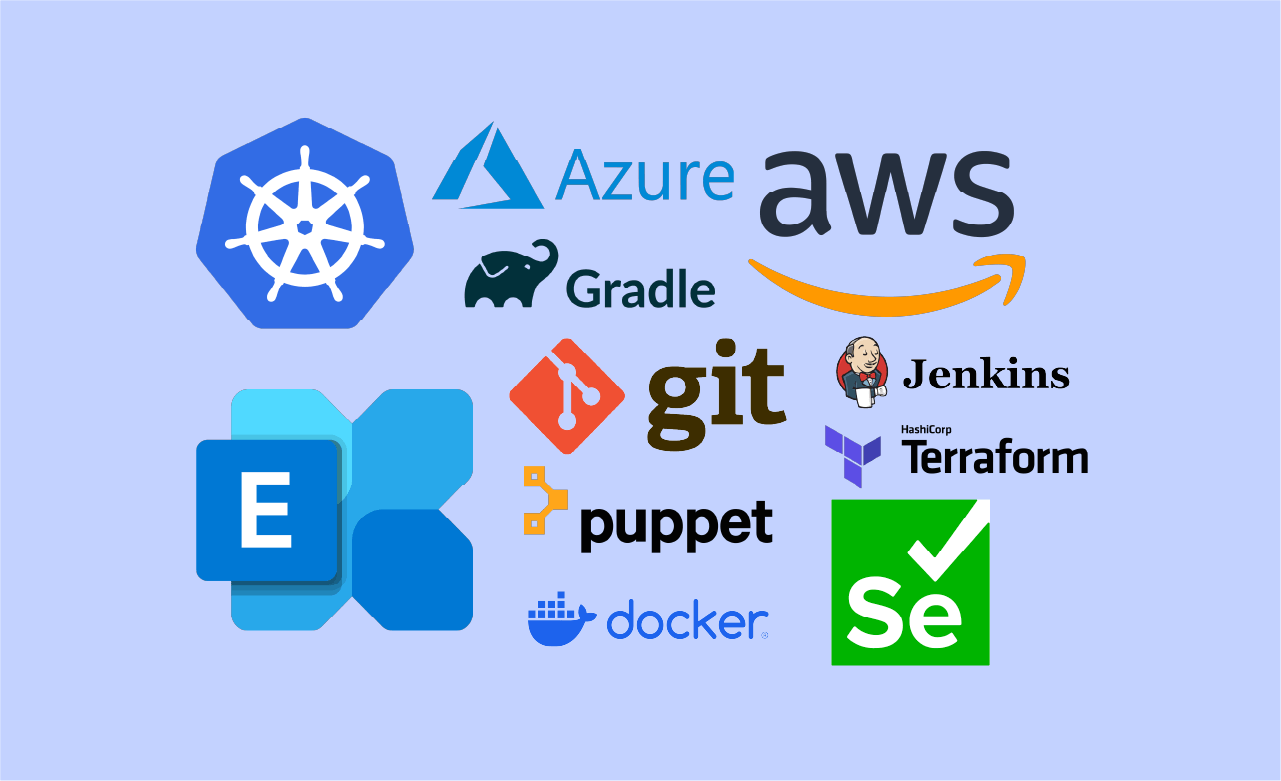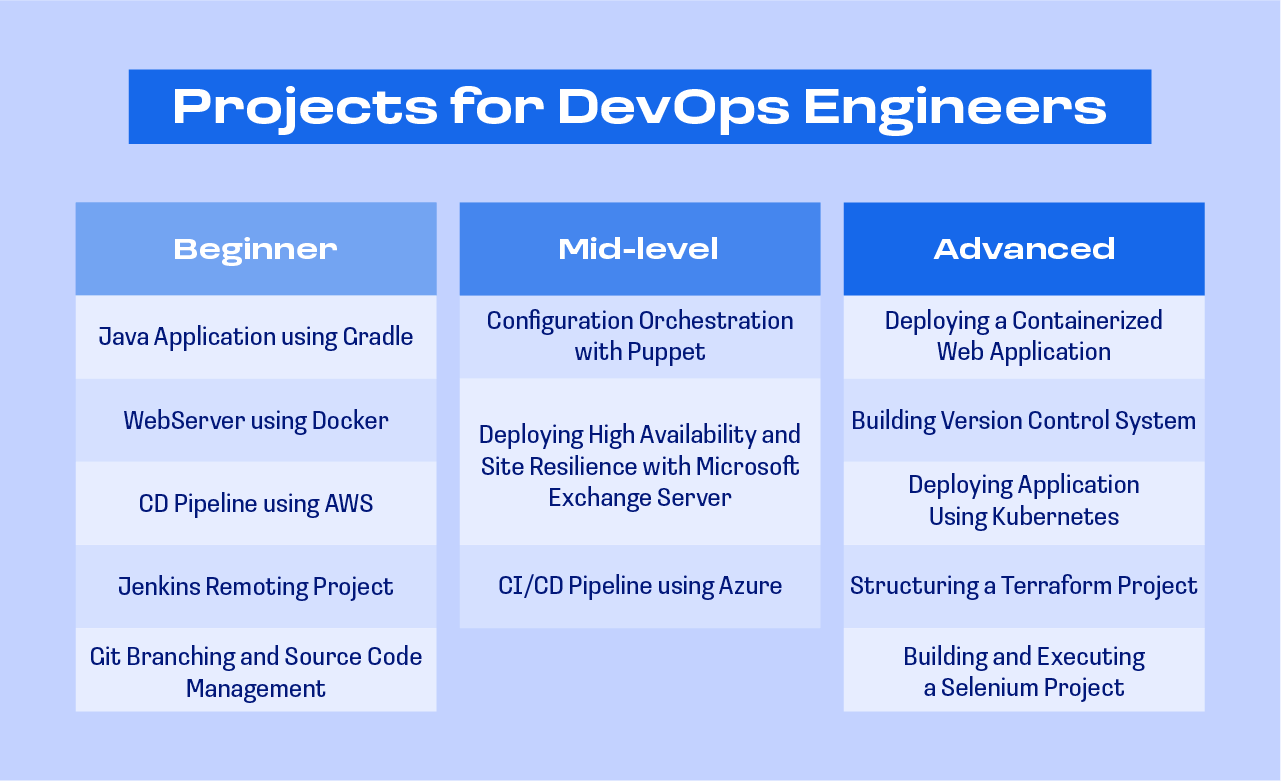Projects for DevOps Engineers: from Beginners to Advanced Level
The author of this article is tech expert Pieter Murphy.
For many in the tech world, choosing to become a DevOps engineer is a lucrative and rewarding path. The DevOps field is growing rapidly and thus offers countless avenues and opportunities for career advancement. In addition, DevOps engineers are in high demand, which attracts a competitive salary.
That said, the most significant reason for being a development and operations professional is the opportunity to make real differences in software development and delivery. DevOps combines development and operations to create a software engineering approach focused on DevOps automation projects at every stage.
DevOps simplifies project service management to support operational goals fully and provides a better understanding of the technology stack used in the production environment.
The approach is founded upon agile methodology and prioritizes collaboration, resource management, and team communication. The key benefits of employing DevOps include stable applications, fast development, and fewer difficulties at the production level.
As an aspiring or professional DevOps engineer, your main role is delivering value as fast and efficiently as possible to your users. One way of gaining proficiency is through DevOps real-world projects.
In this article, we’ve compiled a list of the most practical DevOps engineer project examples you can work on that will fit into and benefit any organization. They’ve been categorized into different experience levels, from beginner to expert.
They cover all the relevant concepts, from deployment automation to developing self-healing infrastructures, to help you on your career path for a DevOps engineer role.

Simple DevOps Projects for Beginners
If you’re new to DevOps and just getting started, you might be wondering whether there are any simple DevOps projects for beginners that they can build. The answer is yes; there are numerous projects that are best suited for beginners and can help you quickly get up to speed.
The following are great sample DevOps projects for beginners and those making the transition to DevOps.
1. Java Application using Gradle
This is a great free DevOps project for students. It involves creating a continuous delivery pipeline using Gradle for a Java application. Java is a popular programming language like Python and C++. Gradle is a powerful tool for automating tasks, managing dependencies, and more.
Additionally, it is a tool that you can learn with relative ease, making it an ideal choice for beginners looking to hone the skills required for a DevOps engineer role.
Working on a Java application brings additional benefits, such as learning about crucial development and operations concepts like Continuous Integration and Delivery (CD/CD). Once you familiarize yourself with DevOps principles, you can experiment with other technologies and languages.
But at the moment, place your focus on Java and Gradle, and you’ll build a solid foundation for becoming an expert DevOps engineer.
2. WebServer using Docker
As a beginner, figuring out where to start on DevOps real-time projects can be difficult. That is why using Docker to set up a WebServer is a good project idea. This DevOps hands-on project will take you through the fundamentals of working with containers and how to use Docker to manage and deploy a web application.
This DevOps project for your resume for freshers will also show you how to monitor for any issues with your server and troubleshoot any arising issues.
If you’re just getting started with DevOps, then you’ll find this project especially useful as it covers all the essential concepts and skills you’ll need as a development and operations engineer. Completing this DevOps real-life project will prepare you for more complex DevOps endeavors.
3. CD Pipeline using AWS
Setting up a continuous delivery pipeline is one effective way of getting started with DevOps, especially if you’re new. A CD pipeline will help you automate the implementation of changes that occur in development into production.
Simply put, a CD pipeline is a way of automating the software development process. It is loved by busy teams looking to avoid the tiring and often erroneous process of manually deploying code changes.
A CD pipeline is beneficial not only to big teams but also to small teams, who can reap enormous benefits that come with automated deployments. Various ways exist to set up a CD pipeline, but most DevOps professionals prefer to use Amazon Web Services (AWS).
With AWS end-to-end DevOps project ideas, you’ll have numerous tools to leverage to build a CD pipeline. They include CloudFormation, CodeBuild, and CodePipeline.
You can use CloudFormation to manage and provision AWS resources like load balancers and EC2 instances. You can package, compile, and test your code using CodeBuild, a managed build service.
CodePipeline is a service that allows you to create step-by-step structures in your CD pipeline, such as deploying and building your program. You can look online for good tutorials on using AWS to set up a CD pipeline and deepen your knowledge on the topic.
4. Jenkins Remoting Project
This is the best DevOps project for freshers, as it’ll give you a secure and stable way of connecting Jenkins nodes together. The Jenkins Remoting Project aims to give developers a set of tools and APIs that will let them control a Jenkins server remotely.
It can be applied to many situations, including providing a higher degree of security through isolating nodes, running tasks on nodes made of different architectures, and distributing build load across multiple nodes.
You can find similar examples of DevOps projects with source code on GitHub. It is relatively easy to get started with, and it is very well-documented. In addition to all the other benefits, this beginner DevOps project for learning will provide several examples of configurations you can use as starting points for new deployments.
This quality makes the Jenkins Remoting project a good choice for anyone wanting to start with DevOps.
5. Git Branching and Source Code Management
Git is one of the most popular names in version control systems, and virtually all developers are familiar with it. Working on this project acts as an explanation of how to use Git’s branching capabilities in your version control process.
As a student, creating the project will improve your skills in implementing Git branching, merging, etc. You will also need to understand versioning comprehensively as part of your DevOps roadmap to grow your career.
Intermediate-level DevOps Projects for Resume
Here are some more complete DevOps projects for portfolio you can try after you gain some experience in DevOps that will boost your resume:
1. Configuration Orchestration with Puppet
With this DevOps sample project, you’ll learn about agent-based configuration management. You’ll understand how Puppet agents enforce desired configurations on managed nodes.
Additionally, you’ll learn how to write Puppet manifests that define system configurations and manage node classification. This DevOps mini project will help you grasp the concepts of idempotent execution and convergence in Puppet to ensure consistent system states.
2. Deploying High Availability and Site Resilience with Microsoft Exchange Server
Site resilience lets messaging operational systems go in case of a site loss while high availability ensures continuous operations or uptime for an extended period of time by removing single points of failure.
With high availability, your applications, databases, and systems will be available whenever and wherever you require them. Microsoft Exchange Server 2013 achieves site resilience and high availability by using the incremental deployment approach.
This is a perfect DevOps resume project as it will demonstrate that you have the ability to set up more than two Exchange 2013 mailbox servers to be stand-alone servers and then configure them and their databases for site resilience and high availability.
The processes of implementing Exchange 2013 differ from organization to organization, but the overall approach to site resilience and high availability is still pretty much the same.
3. CI/CD Pipeline using Azure
A CI/CD pipeline is an integral part of DevOps. You can improve the quality of your code and speed up the software development process by automating the deployment, test, and build process.
Azure has numerous powerful tools that you can use to implement a CI/CD pipeline. The tools include Azure App Service, Azure Container Registry, and Azure Pipelines. Through this DevOps practice project, you’ll acquire ways of using these services to make complete CI/CD pipelines for web applications.
It will teach you to monitor any pipeline and ensure it runs without problems. If you’re just starting with DevOps and want to know more about important technologies and concepts, this project is perfect for you.
You should also consider working with similar Azure open-source DevOps projects for practice and build your knowledge.
If you are considering branching into a DevOps architect role, check out this guide of the roles and repsonsbilities that entails.
Advanced DevOps Projects for Portfolio
Even as a full Azure or AWS DevOps engineer, you must keep up with the latest best practices, advancements, and trends to stay ahead of the curve in this field.
This is why we’ve developed a list of advanced projects for a DevOps engineer that you can use to refine your skills and stay updated with all the latest changes.
These DevOps home projects will help you realize your DevOps mastery from container orchestration to serverless computing.
1. Deploying a Containerized Web Application
Do you want to gain some hands-on training on DevOps? One effective way of doing this is by deploying a containerized web application. This will allow you to practice and work with several DevOps tools.
It will also teach you ways of automating, deploying, testing, and building software. You can go about this in many ways, but we recommend the popular approach of using Docker containers.
This will let you package an application into a self-contained unit, making it easy to deploy on any server. Another benefit of working with containers is that they allow you to run multiple versions of the same application side-by-side, which is very helpful, especially regarding testing.
Once you containerize your application, you can set up a CI/CD pipeline. This will make the process of building, testing, and deploying the application automatic. You can use tools like CircleCI, Travis CI, or Jenkins for this.
On top of that, through this small project, you’ll teach yourself how to use Kubernetes and Docker to deploy simple containerized web applications. You’ll also better understand scaling and configuring the application for high availability.
By the end of the project, you’ll have all the skills you need to deploy containerized applications in production environments.
2. Building Version Control System
Software development teams rely on a Version Control System (VCS) as it is an important tool that lets them collaborate with teammates, track changes to their code, and easily go back to previous versions.
Many different VCSes exist, but the most popular ones are Mercurial and Git. In this project, you’ll set up your Git server and learn how to utilize it for collaborative development. You’ll also learn more about integrating development and operations projects with Jenkins, GitHub, and many more.
By completing this DevOps portfolio project, you’ll gain invaluable knowledge of how version control works and how it can be used to help manage the codebase.
Remember, this is an advanced DevOps project. Therefore, it’s recommended that you first gain some experience with DevOps before trying it out.
3. Deploying Application Using Kubernetes
Kubernetes is an open-source container orchestration platform. It automates the containerization, management, scaling, and deployment of applications. For this demo project, you’ll need to use a Kubernetes cluster to deploy a simple web application.
It will teach you how to make Kubernetes objects like secrets, services, and deployments. You’ll also learn ways of using Kubernetes Dashboard to monitor and access your application.
Moreover, the DevOps open-source project will let you work with various aspects of Kubernetes, like services, deployments, and pods. It will also allow you to experiment with dealing with failures and scaling the application.
Through this project, you’ll gain a deeper understanding of development and operations and discover ways of applying it to real-world scenarios.
4. Structuring a Terraform Project
Any serious DevOps engineer knows that Terraform is crucial in any infrastructure-as-code toolkit. So, if you’re interested in upping your DevOps game, there is no better way to do it than by exploring a couple of advanced Terraform projects for experienced engineers.
One effective way of learning is through examples; an ideal place to begin is with the structure of a Terraform project. A well-structured Terraform project makes your code easier to maintain and more readable, which is necessary when you have complex infrastructure.
When you’re starting, we recommend using a boilerplate project structure, as it will prove helpful because you can customize it to your needs. After you gain more confidence, you’ll be free to explore new ways to organize your code.
Once the basic structure is in place, you can consider modularizing your code. Use the powerful modularization technique to make your code easier to update and more readable.
Modularization can reduce your infrastructure’s overall complexity if you do it correctly.
You should experiment as much as possible with the many ways of modularizing your code to arrive at the approach that best suits you as a side project. A carefully designed Terraform project will ensure that your infrastructure will be much easier to maintain and manage.
5. Building and Executing a Selenium Project
Students have many different types of real-time projects in DevOps that they can take up for practical experience. A perfect DevOps example project is executing and building a Selenium project.
Selenium is an essential tool in modern software development that automates web browsers. For this DevOps personal project, you’ll need a solid web development and automation foundation.
With a strong understanding, you can perform advanced real-time projects on DevOps, such as creating and executing Selenium. This project will assist you in consolidating your skills and knowledge.
Additionally, when you complete this project, you’ll have an example of how development and operations concepts apply in a real-world scenario.
Check out our Azure DevOps career path brief to learn how to specialize your skills as an engineer in Microsoft’s cloud.

Conclusion
The real-time DevOps project examples herein equip you with all the relevant skills for a successful career in DevOps.
So, if you’re seeking ways of streamlining or improving your process, these DevOps live projects are the surest way to get there. You can also make use of resources that include DevOps books, open-source projects, seminars, events, and other materials that keep you updated and add to your knowledge base.
They’re based on real-world experiences and have been tested and proven to deliver actual results.


.png)
